LG Optimus 2X & NVIDIA Tegra 2 Review: The First Dual-Core Smartphone
by Brian Klug & Anand Lal Shimpi on February 7, 2011 3:53 AM EST- Posted in
- Smartphones
- Tegra 2
- LG
- Optimus 2X
- Mobile
- NVIDIA
Performance Analysis
Android’s browser is multithreaded, but again certain workloads and pages lend themselves to parallelization much better than others. When it comes to our page load suite, the 2X is almost class leading, though our results are starting to get very cramped and clustered among the same grouping of Android versions. All of the Android browsers in these tests have Flash enabled as well. Anand and I are working on setting up a much more comprehensive and sophisticated page load test with much better repeatability, as the current version has become a bit unwieldy. Expect to see that soon, but for now we're using the old method.
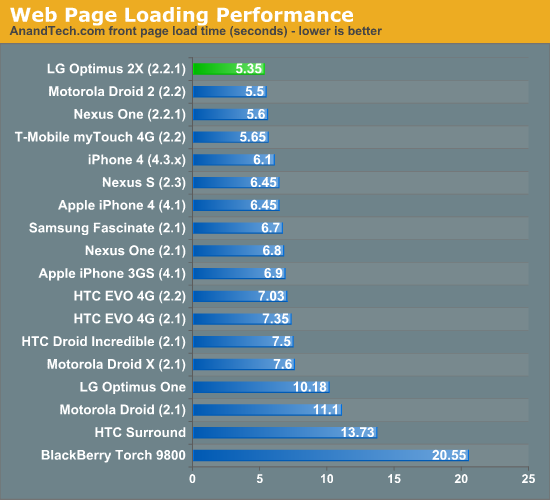
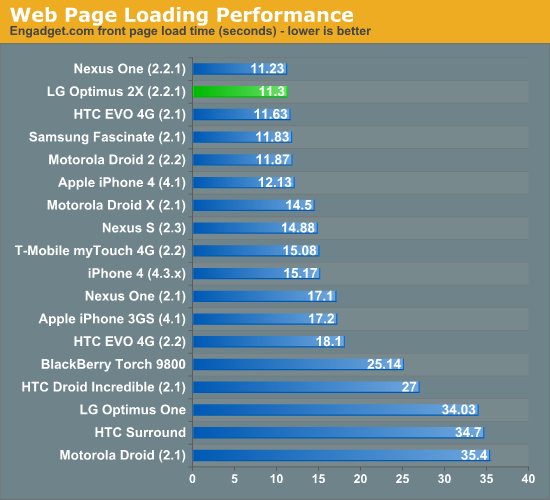 ;
;
Panning and zooming on the 2X is speedy, even if it’s still choppier than the Galaxy S’ hardware accelerated browser. What’s really noticeable on the 2X is how fast Adobe Flash is. Generally while browsing I can feel when Flash ads are really slowing a page down—the 2X almost never felt that way. The 2X was running Flash version 10.1.120.10 which is newer than the version available in the market at current writing. The Flash version in the market has a number of warnings cautioning against installing the current market version on the 2X or a Tegra 2 powered phone as only the preloaded version has Tegra 2 optimizations. Thankfully these are being rolled into the next market release so there won’t be any Flash version fragmentation.
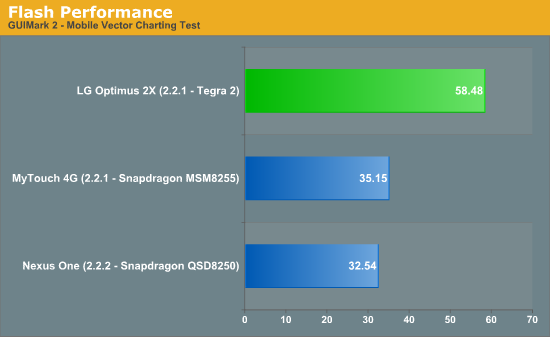
We tested with GUIMark2’s mobile Flash charting test which has a nice framerate counter and test mode. The results speak for themselves, Flash feels dramatically faster on here than any other platform we’ve tested. We still don't have a Galaxy S device with 2.2 officially on it, and therefore don't have a comparison from Hummingbird-based phones.
You can see how snappy the browser is (including page load, pan and zoom speed, and Flash performance) at 12:40 in our LG Optimus 2X Overview video:
Moving along is the SunSpider Javascript benchmark, which is a regular fixture in our smartphone reviews. The benchmark measures the performance of various Javascript code snippets designed to represent real world js usage. When run on a smartphone it gives us the idea of how fast the browser, OS and hardware platform (including SoC) is at running these Javascript tests. Good js performance alone isn't enough to provide a fast web browsing experience, but it's one component.

Google has been on a Javascript performance optimization rampage since Android's initial release. You get a hint of that here when you look at the clustering of Android scores. The move from Android 1.6 to 2.1 was responsible for a big jump in performance, and we saw another major improvement with the move to Froyo (2.2).
The SunSpider benchmark isn't explicitly multithreaded, although some of the tests within the benchmark will take advantage of more than one core. As a result, some of the performance gain here over a Cortex A8 is due to the out-of-order execution engine and shorter pipeline of the Cortex A9 and not just the two cores.
The Motorola Droid 2 uses a TI OMAP 3620 with a single 1GHz Cortex A8 core. As such it is the best hardware comparison to the LG Optimus 2X with its dual Cortex A9 cores. The performance improvement here is very good. NVIDIA's Tegra 2 manages a 64% faster score under SunSpider than the OMAP 3620 based Droid 2. The advantage over Samsung's Hummingbird SoC is narrower but still an impressive 44%.
The comparison to T-Mobile's myTouch 4G is very telling. The myTouch 4G uses the latest 45nm SoC from Qualcomm. Architecturally this SoC still has the same Scorpion CPU core as previous Snapdragons, but the difference here is the memory interface. The 45nm Snapdragons feature a LP-DDR2 memory interface vs. the LP-DDR1 interface from the 65nm versions. The faster memory interface is likely responsible for the improved performance here.
With a faster memory bus, Qualcomm's 45nm Snapdragon closes the gap between it and the Optimus 2X's Tegra 2. NVIDIA only holds a 12.5% performance advantage here vs. Qualcomm's single core 45nm Snapdragon. A 1.2GHz dual-core Snapdragon (the 8660) would likely outperform NVIDIA's Tegra 2 in this test.
In terms of currently available hardware however, the LG Optimus 2X is clearly the fastest device we have running SunSpider. And NVIDIA's Tegra 2 is the fastest SoC in our SunSpider benchmarks.
Rightware's BrowserMark is another JavaScript performance benchmark. Rightware modeled its benchmark after the JavaScript frameworks and functions used by websites like Facebook, Amazon and Gmail among others. The results are simply one aspect of web browsing performance, but an important one:
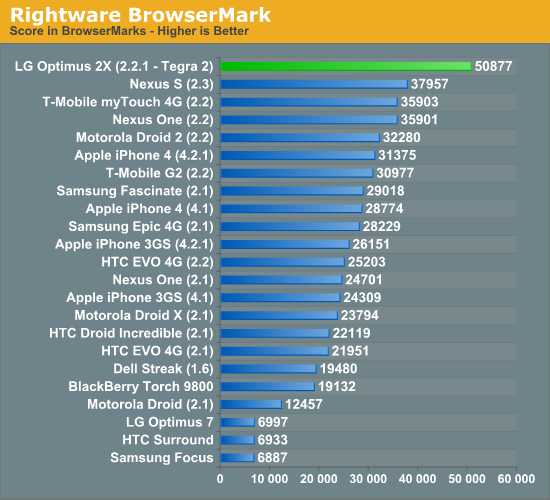
BrowserMark shows the Optimus 2X with a 57% performance advantage over the Motorola Droid 2. The performance advantage is similar to what we saw in our SunSpider results. The gap doesn't close by much as we look at Samsung Hummingbird and Qualcomm Snapdragon based SoCs. NVIDIA and LG maintain a 41.5% performance advantage over the 45nm Snapdragon based myTouch 4G.
It's still difficult to draw real conclusions about why some SoCs perform better than others, however in this case I'd guess that it's probably equal parts A9 and dual-core giving the Tegra 2 its performance advantage in BrowserMark.
The combination of these two js benchmarks proves one point: the LG Optimus 2X and NVIDIA's Tegra 2 provide the fastest Android web browsing experience we've seen thus far. A message that is continuously echoed in our day to day use of the phone. The Optimus 2X is the first Android phone to render web pages as quickly, if not quicker, than the iPhone 4.
WiFi performance is often surprisingly bad on smartphones we test for some reason. Thankfully, the LG Optimus 2X did very well in our tests:
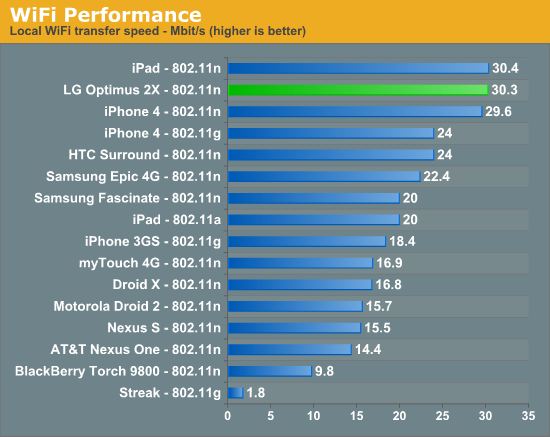
At 30.3Mbps, the Optimus 2X all but tied the iPad for local network WiFi performance. It's not only the fastest Android phone we've run through our WiFi test, but also the fastest WiFi we've tested on a smartphone in general. Congrats to LG.
One of the original Android 3D benchmarks, Neocore has lost much of its usefulness over the past year. With the move to PowerVR SGX 535/540 and Adreno 205 GPUs in newer SoCs we run into a curious problem—nearly all of the high end GPUs converge at around 60 fps:
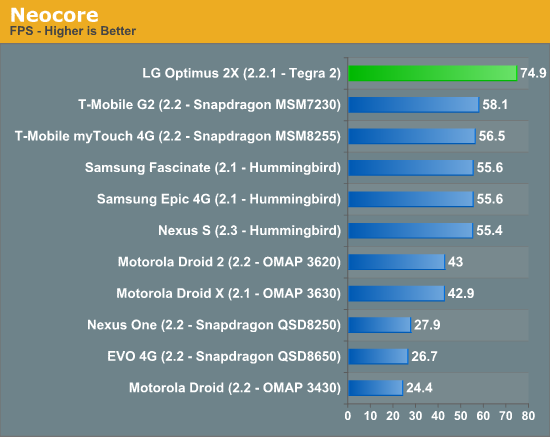
This isn't some mystic performance convergence, rather it's the OS-wide frame rate cap both Qualcomm and Imagination Technologies implement on their drivers. Neocore can't physically run any faster because the graphics driver won't allow it. The idea behind the cap is simple. Running at higher frame rates would simply run the GPU faster, which would require data from the CPU more quickly and in turn fire the memory interface more often and just draw a lot more power. Limting frame rate to 60 fps keeps performance nice and smooth but conserves battery life at the same time.
With a 60 fps limit, we can't use Neocore to tell the difference between GPUs and SoCs capable of running the benchmark at higher frame rates—everything looks the same. So why does the LG Optimus 2X score 74.9 fps? NVIDIA is no stranger to benchmarking—it simply raised the frame rate limit to 117.5 fps across the OS, and as a result we get a meaningful score in Neocore from at least one high end GPU.
Unfortunately this tells us nothing about how Tegra 2 stacks up against the PowerVR SGX 535/540 or Qualcomm's Adreno 205. The only things we can conclude are: 1) NVIDIA is going to eat the competition for breakfast once more smartphone benchmarks are available and we start playing optimization games, and 2) Neocore is a meaningless benchmark and should be retired.
This next benchmark needs no introduction. Quake 3 graced the pages of AnandTech years ago, serving as a great GPU and eventually an even better CPU benchmark as our systems grew to be more powerful. While hardly representative of the type of 3D games that are being ported to smartphones today, Quake 3 remains an interesting measure of GPU and SoC performance.

NVIDIA's Tegra 2 is clearly faster than Qualcomm's MSM7230, however it plays second fiddle to the PowerVR SGX 540 in Samsung's Hummingbird. The why is difficult to explain. Quake 3 is a fairly simple game by today's standards. There are several layers of texturing but no pixel or vertex shaders and very little geometry. Running on modern hardware, Quake 3 is a GPU texturing/ROP test and a triangle setup test. Performance here should be influenced by the memory interface, cache performance, CPU-GPU interface as well as the GPU's ability to churn out textured pixels. I suspect that NVIDIA's driver and GPU itself just aren't optimized for this type of a game. The performance is decent, but it's no faster than a PowerVR SGX 540.

The Cortex A8's FPU wasn't pipelined and thus presented serious performance limitations when used. The Cortex A9 corrects this and thus we see a huge performance increase in Linpack. Qualcomm however appears to have always had a pretty decent FP setup in its Scorpion core, resulting in comparable performance to what NVIDIA delivered with Tegra 2.
It's unclear to us how much of the Linpack Android port uses VFP code vs. NEON code. Based on the results here it would appear to be a VFP benchmark, not touching NEON at all. In addition, the Linpack test we use from the Android market appears to be single-threaded.
Quadrant
Quadrant is one of the unfortunate realities of Android smartphone benchmarking today: we have a lot of synthetic benchmarks that give us relatively little insight into real world app performance. While I expect the smartphone benchmarking tools to improve over the coming 24 months, we'll have to make do for now.

Quadrant provides an overall score as well as individual category scores. As you'd expect, NVIDIA's Tegra 2 is on top. CPU performance, as measured in Quadrant, is 38% faster than the fastest SoCs on the market today. Given that this is a purely synthetic test I'd expect to see smaller gains in real world apps. Quadrant's CPU benchmark, like linpack, also is just a single thread:

What is surprising is just how well the Tegra 2 does in Quadrant's memory and I/O benchmarks:
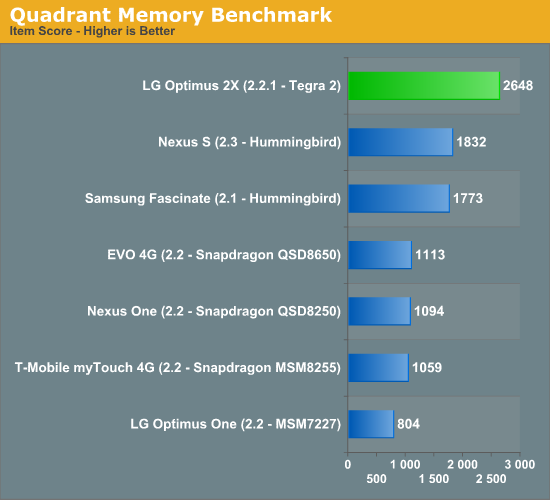
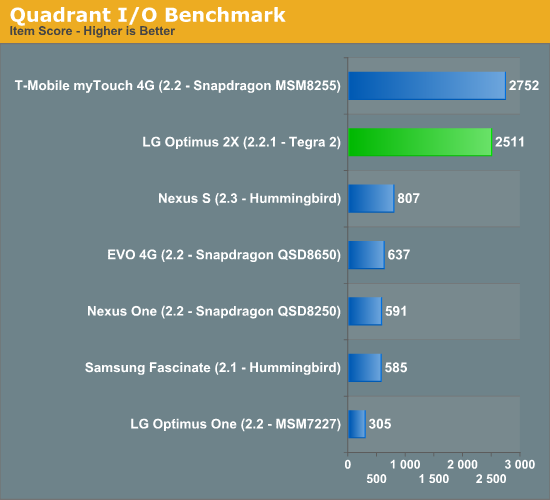
The Quadrant developers aren't very open about what these tests do other than obviously stress the memory interface and stream data over the I/O bus. NVIDIA has claimed that it has the best memory controller and arbitration logic of any of the SoC players. These advantages could be the cause of NVIDIA's solid showing in Quadrant's memory and I/O tests.
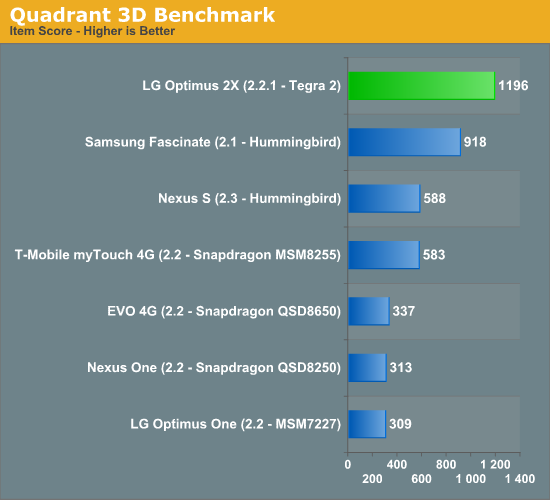
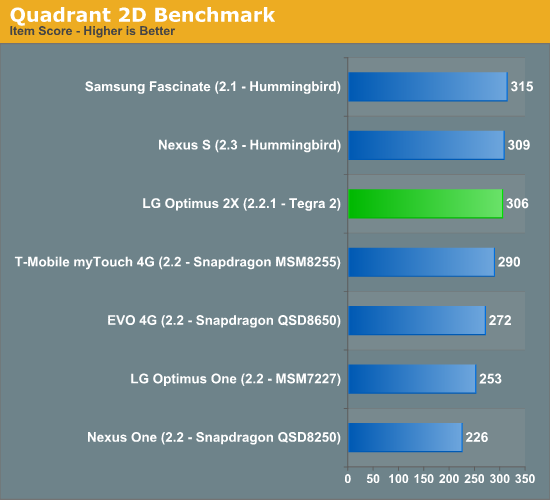
GLBenchmark 2.0
GLBenchmark 2.0—as its name implies—tests OpenGL ES 2.0 performance on compatible devices. The suite includes two long benchmarking scenarios with a demanding combination of OpenGL ES 2.0 effects, and individual tests such as swap buffer speed (for determining the framerate cap), texture fill, triangle, and geometric tests. GLBenchmark 2.0 also leverages texture based and direct lighting, bump, environment, and radiance mapping, soft shadows, vertex shader based skinning, level of detail support, multi-pass deferred rendering, noise textures, and ETC1 texture compression.
GLBenchmark 2.0 is the best example of an even remotely current 3D game running on Android—and even then this is a stretch. If you want an idea of how the Tegra 2 GPU stacks up to the competition however, GLBenchmark 2.0 is probably going to be our best bet (at least until we get Epic to finally release an Unreal Engine benchmark for Android).
The first benchmark, Egypt, tests OpenGL ES 2.0 and represents the newest and most demanding benchmark. The second— GLBenchmark PRO—also tests OpenGL ES 2.0 features, and is a port of an earlier GLBenchmark 1.1 test which focused on OpenGL ES 1.1 performance).

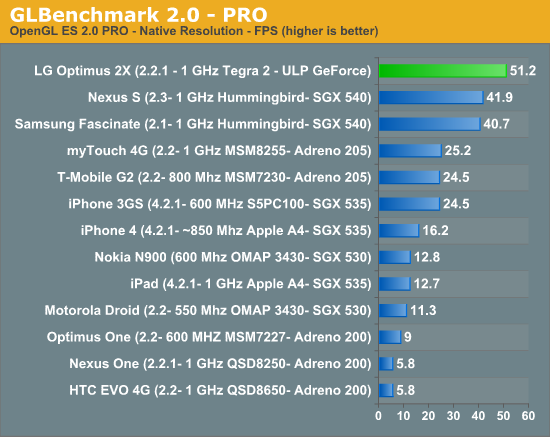
In both OpenGL ES 2.0 benchmarks NVIDIA's Tegra 2 comes out ahead of PowerVR's SGX 540. Granted it's impossible to know how much of this is driver optimization for the benchmark vs. pure hardware capability, but I'd expect that these results are reasonably believable. NVIDIA's Tegra 2 looks to be 15—25% faster than the PowerVR SGX 540 based Samsung Hummingbird SoC. Not all of this is going to be due to the GPU as even the most taxing games run on smartphones are still quite CPU bound at times.
BaseMark GUI Benchmark
Basemark divides benchmarking into two categories—feature tests and the final overall user interface test. We couldn't get the UI test to run reliably on the Optimus 2X so we'll be looking at the feature tests exclusively. These are named animation, vertex streaming, texture streaming, and alpha blending as shown in the menu above. Each tests a different collection of what Rightware believes are representative graphics tasks that will be leveraged in user interfaces moving forward.
First up among those feature tests is animation, which animates a graphics element (in this case, a robot moving through a set of actions) by stepping through a table of keyframes and interpolating the character's movement between using splines. This particular benchmark uses ES 2.0 APIs and per vertex lighting, but the purpose of this test is to be as CPU-bound as possible and specifically stress floating point performance.
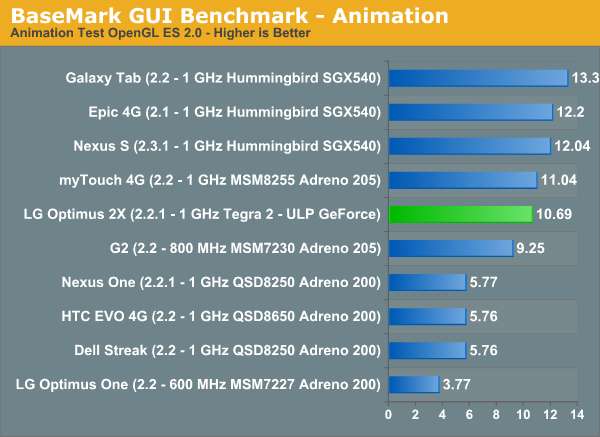
NVIDIA's Tegra 2 has no SIMD FP engine (NEON) and instead relies on ARM's first fully pipelined FPU. The result is competitive performance to the NEON equipped Hummingbird and Snapdragon SoCs, but not better performance. NVIDIA told us that to implement NEON would be to incur a 30% die penalty for a performance advantage that would only impact a small portion of your code. It remains to be seen how much the NEON tradeoff will actually cost NVIDIA this generation. If BaseMark's Animation benchmark is any indication, the penalty may not be all that bad.
Next are the vertex and texture streaming tests, both of which measure asset streaming performance—according to RightWare, effectively memory bandwidth. The vertex test loads geometry data into GPU memory and frees it when no longer needed. The scene itself involves a lot of geometry—ten repeating city blocks which the camera moves through with increasing speed and draw distance. The test ramps from around 3k vertices to 15k vertices per frame, and 190k to 250k triangles per frame. There's a single texture material, fog, two lights, and OpenGL ES 2.0 shaders which use per vertex lighting.
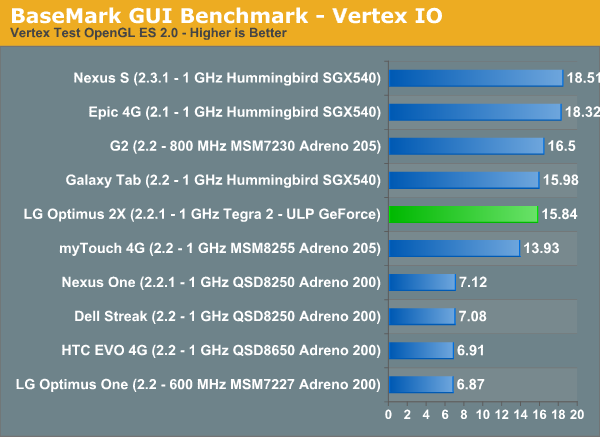
The Vertex IO test is an important test of performance as it measures the CPU-GPU interface bandwidth, vertex shader performance and memory bandwidth. NVIDIA does well here but and remains competitive with Samsung & Qualcomm, although definitely not faster.
The texture test is a bit more straightforward, quickly loading images from RAM into the GPU memory and discarding them.
These asset streaming tests effectively test memory bandwidth from disk into RAM and into to GPU memory. Although Kanzi supports ETC texture compression (and Basemark exposes this option for testing), we've initially tested with the default configuration which has ETC texture compression disabled.
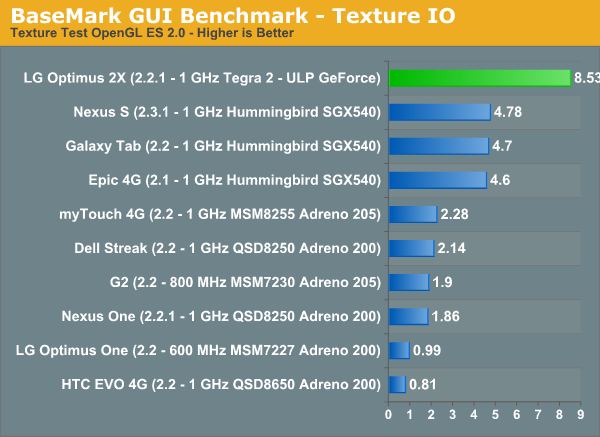
Quadrant implied that NVIDIA's paths to NAND and main memory were both ridiculously quick. BaseMark's Texture IO test corroborates the implication. The Optimus 2X manages a score here that's nearly twice that of the closest competitor. A fast memory and I/O interface never hurts. I am curious to know how much of the performance here is due to NVIDIA's new ROPs that reuse pixel shader hardware.
Blend testing—as its name implies—tests alpha blended rendering by drawing a number of semi-transparent contact cards atop each other. These are overlaid sequentially until we reach a desired number of layers. This test actually runs twice, first with front to back ordering of these contact cards, and then with back to front ordering.
This ordering difference shouldn't be confused with the fact that feature test actually runs in both back to front and front to back rendering orders and are combined later.
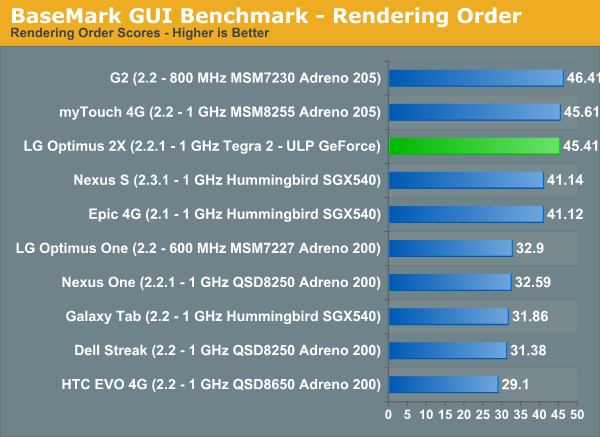
Next is the composition test, which composites interface screens rendered off-scene into one large tiled user interface. The example here are applications rendering in the background being composited into one view. This test combines 16 off-scene objects.
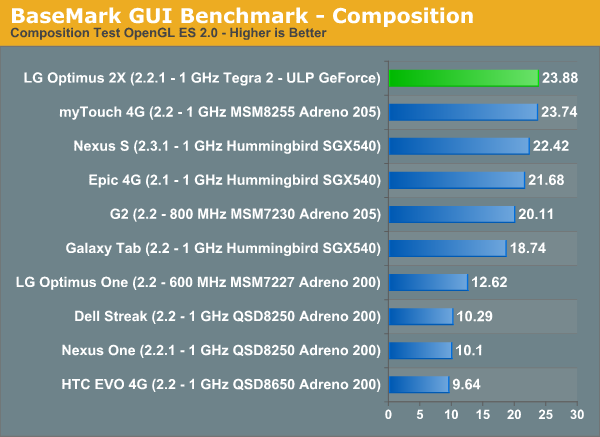
The composition test puts NVIDIA's Tegra 2 and the Optimus 2X at the top of the chart. As a result, Android UI performance feels very snappy running on Tegra 2. All we need now is Gingerbread.





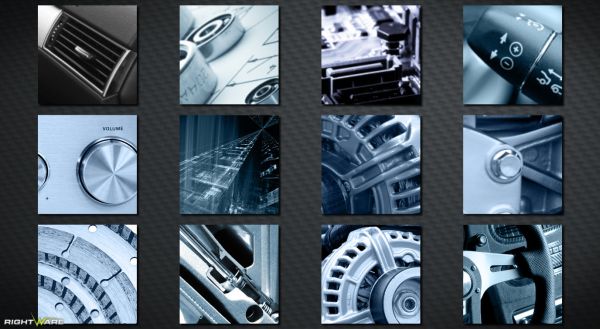

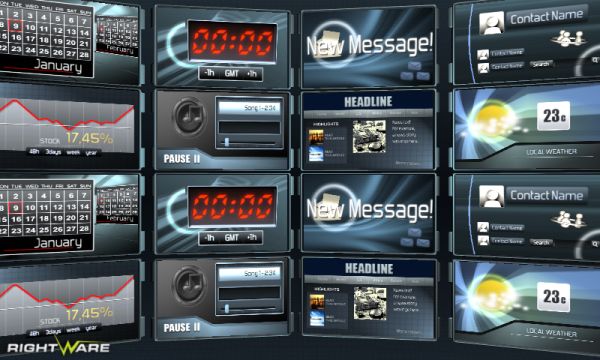








75 Comments
View All Comments
Exophase - Monday, February 7, 2011 - link
Thanks Anand.I'm surprised to hear that shot was from IMG, given that it was an IMG employee who made the comment originally about Tegra's 16-bit banding being evident on it, from the screenshot. Whoops. I do wonder what could be causing this, then.
Nonetheless, while that definitely makes my 16bit color claim invalid the depth buffer one should still hold. We might need to wait and see how much of a difference this actually makes, or rather how effective nVidia's 16-bit depth space is.
I'm glad to hear that you're as concerned about benchmarks on Android as I am. It's especially frustrating when I see people using them to try to indicate Atom being substantially better clock for clock than Cortex-A9.
Exophase - Monday, February 7, 2011 - link
Managed to miss this:"The test ramps from around 3k vertices to 15k vertices per frame, and 190k to 250k triangles per frame"
That line doesn't make any sense. How would you have hundreds of times more triangles than vertices? You must have meant something else.
sid1712 - Monday, February 7, 2011 - link
Great review as usual but i'm disappointed about the lack of details on the Sound Quality of the phone. A comparison of the sound quality (via headphone jack) alongside the iPhone 4 and the Galaxy S (with Voodoo kernel preferrably) would give a good idea about the SQ of the phone.ScentedKandle - Monday, February 7, 2011 - link
Related to this, the audio codec lists "lossless" but doesn't mention what format. Can the audio chip natively decode FLAC?teldar - Monday, February 7, 2011 - link
The order of buttons if the same as my droid x.Pjotr - Monday, February 7, 2011 - link
Does it really record 1920x1088? Does this unorthodox resolution play well on TVs, if you put it on a USB stick, for example?Brian Klug - Monday, February 7, 2011 - link
It plays back from the phone properly, and most of the playback software just does a crop. A ton of devices actually produce 1088 and don't make note of it, it should playback fine.-Brian
unmesh - Monday, February 7, 2011 - link
For active aka switching transistor power consumption, C*V^2*f (C is capacitance and f is frequency) is a better proxy than V^2/R.The conclusion that operating voltage has a huge effect remains the same.
Kevin098 - Monday, February 7, 2011 - link
Hey, can you make a video comparison between the iphone 4 retina display and Optimus 2x ?StormyParis - Monday, February 7, 2011 - link
Pages and pages of (apparently not very acurate, too) perf data, and not even one line on sound quality, which is one of my key buying points for a phone.No info on whether I'll be able to stream PC-resolution videos off my server to my bed over wifi.
Overall, not a very useful review. More like a dick size contest.